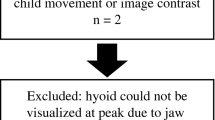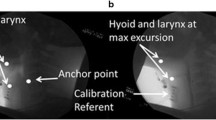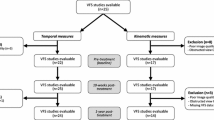Abstract
There has been little attention given to the relationship between variations in normal craniofacial morphology and swallowing physiology. This preliminary investigation evaluated the relationship between the Frankfort-mandibular plane angle (FMA) and hyoid displacement during swallowing. Hyoid movement was evaluated during 12-ml and 24-ml swallows of liquid barium in 12 healthy subjects (age = 20–29 years, median = 23 years). Lateral projection videofluorography was utilized. Positions of the hyoid at maximum forward displacement, maximum upward displacement, starting position, and ending position were determined using image analysis software. The mean FMA was 28.92° ± 4.08° (mean ± SD, range = 20°–34°). A Pearson correlation (≤0.05) demonstrated that hyoid forward displacement was significantly inversely correlated with the FMA [R = −0.68, p = 0.015 (12 ml) and R = −0.72, p = 0.009 (24 ml)]; thus, the greater the FMA, the smaller the hyoid forward displacement. Upward displacement of the hyoid was not significantly correlated with FMA for 12-ml (R = −0.41, p = 0.55) or 24-ml swallows (R = 0.21, p = 0.512). In addition, there was no significant correlation between hyoid starting or ending positions. In conclusion, the results of this preliminary study suggest that normal variations in morphology, as measured by the FMA, may influence hyoid movement and therefore affect swallowing physiology.



Similar content being viewed by others
References
Palmer JB, Kuhlemeier KV, Tippett DC, Lynch C. A protocol for the videofluorographic swallowing study. Dysphagia. 1993;8:209–14.
Palmer JB, Rudin NJ, Lara G, Crompton AW. Coordination of mastication and swallowing. Dysphagia. 1992;7:187–200.
Palmer JB, Drennan JC, Baba M. Evaluation and treatment of swallowing impairments. Am Fam Physician. 2000;61:2453–62.
Mayo C. Gray’s anatomy: anatomy of the human body, 29th ed. Philadelphia: Lea and Febiger; 1973, p. 156–8.
Stepovich ML. A cephalometric positional study of hyoid bone. Am J Orthodontics. 1965;51(12):882–99.
Sivarao DV, Goyal RK. Functional anatomy and physiology of the upper esophageal sphincter. Am J Med. 2000;108(4A):27S–37S.
Spiro J, Rendell JK, Gay T. Activation and coordination patterns of the suprahyoid muscles during swallowing. Laryngoscope. 1994;104:1376–82.
Cook IJ, Dodds WJ, Dantas RO, Massey B, Kern MK, Lang IM, et al. Opening mechanisms of the human upper esophageal sphincter. Am J Physiol. 1989;257(5 Pt 1):G748–59.
Jacob P, Kahrilas PJ, Logemann JA, Shah V, Ha T. Upper esophageal sphincter opening and modulation during swallowing. Gastroenterology. 1989;97:1469–78.
Fujiki T, Inoue M, Miyawaki S, Nagasaki T, Tanimoto K, Takano-Yamamoto T. Relationship between maxillofacial morphology and deglutitive tongue movement in patients with anterior open bite. Am J Orthod Dentofacial Orthop. 2004;125(2):160–7.
Cheng C, Peng C, Chiou H, Tsai C. Dentofacial morphology and tongue function during swallowing. Am J Orthod Dentofacial Orthop. 2002;122(5):491–9.
Cuozzo GS, Bowman DC. Hyoid positioning during deglutition following forced positioning of the tongue. Am J Orthod. 1975;5:564–70.
Ishida R, Palmer JB, Hiiemae KM. Hyoid motion during swallowing: factors affecting forward and upward displacement. Dysphagia. 2002;17:262–72.
Gay T, Rendell JK, Spiro J, Mosier K, Lurie AG. Coordination of oral and laryngeal movements during swallowing. J Appl Physiol. 1994;77(1):357–65.
DiPietro GJ, Moergeli JR. Significance of the Frankfort-mandibular plane angle to prosthodontics. J Prosthet Dent. 1976;36(6):624–35.
Hocevar RA, Stewart MC. A study of reference lines for mandibular plane angles. Am J Orthod Dentofacial Orthop. 1992;102(6):519–25.
Palmer JB, Hiiemae KM, Liu J. Tongue-jaw linkages in human feeding: a preliminary videofluorographic study. Arch Oral Biol. 1997;42(6):429–41.
Gerstner GE, Marchi F, Haerlan H. Relationship between anteroposterior maxillomandibular morphology and masticatory jaw movement patterns. Am J Orthod Dentofacial Orthop. 1999;115:258–66.
Moller E. The chewing apparatus. Acta Physiol Scand. 1966;69 Suppl 280:1–229.
Throckmorton GS, Finn RA, Bell WH. Biomechanics of differences in lower facial height. Am J Orthod. 1980;77(4):410–20.
Muto T, Kanazawa M. Positional change of the hyoid bone at maximal mouth opening. Oral Surg Oral Med Oral Pathol. 1994;77:451–5.
Dodds WJ. The physiology of swallowing. Dysphagia. 1989;3:171–8.
Shaker R, Kern M, Bardan E, Taylor A, Stewart ET, Hoffmann RG, et al. Augmentation of deglutitive upper esophageal sphincter opening in the elderly by exercise. Am J Physiol. 1997;272(6 Pt 1):G1518–22.
Acknowledgments
This work was completed at the Department of Physical Medicine and Rehabilitation, Good Samaritan Hospital, Johns Hopkins University, Baltimore, Maryland. The work was supported in part by award Nos. T32 DE07309 from the NIDCR/NIH and R01 DC002123 from the NIDCD/NIH. The authors would like to thank Chune Yang for providing technical assistance, and the late Dr. Karen Hiiemae for her assistance in collecting data and planning this project.
Author information
Authors and Affiliations
Corresponding author
Rights and permissions
About this article
Cite this article
Mays, K.A., Palmer, J.B. & Kuhlemeier, K.V. Influence of Craniofacial Morphology on Hyoid Movement: A Preliminary Correlational Study. Dysphagia 24, 71–76 (2009). https://doi.org/10.1007/s00455-008-9176-x
Received:
Accepted:
Published:
Issue Date:
DOI: https://doi.org/10.1007/s00455-008-9176-x




